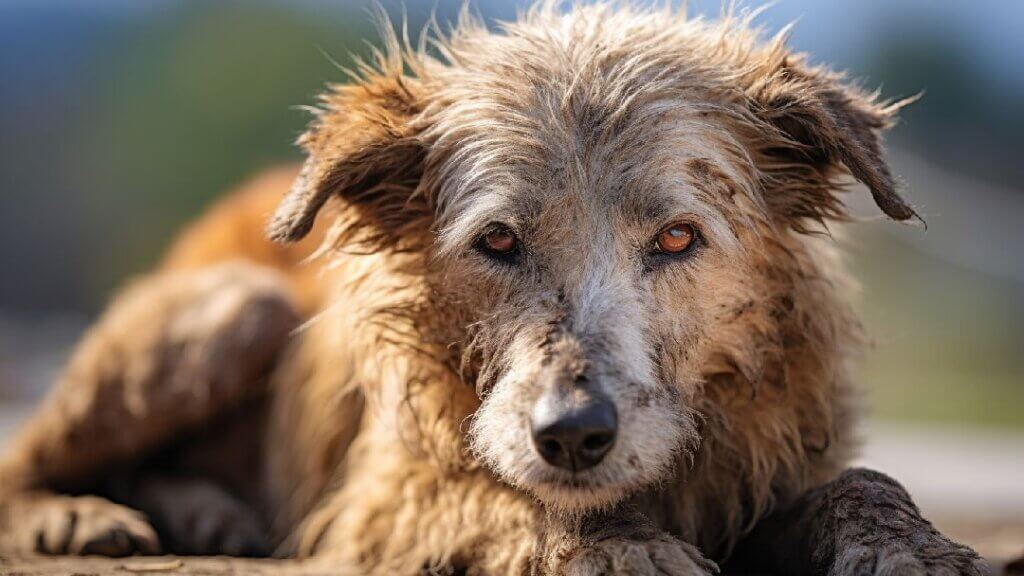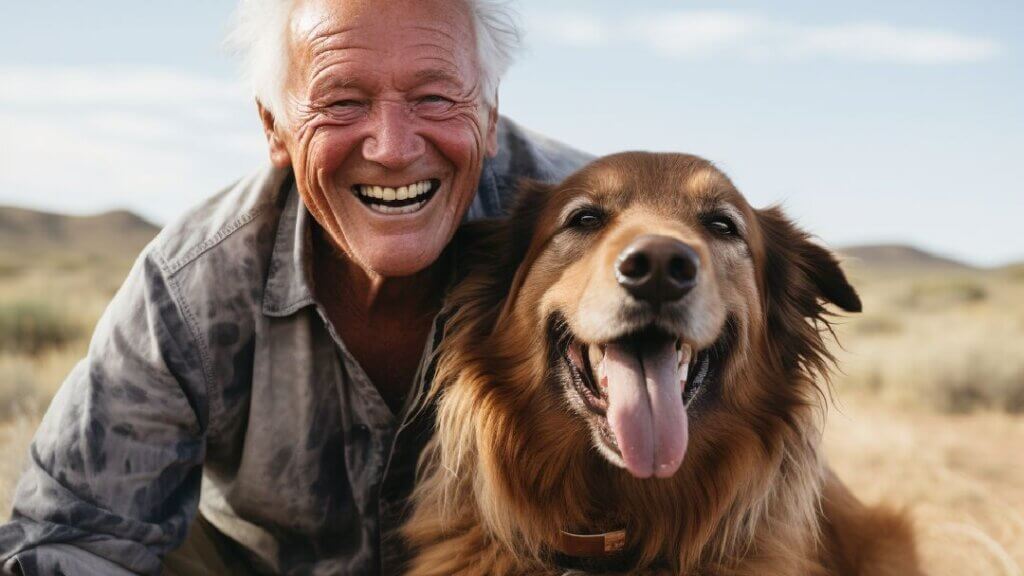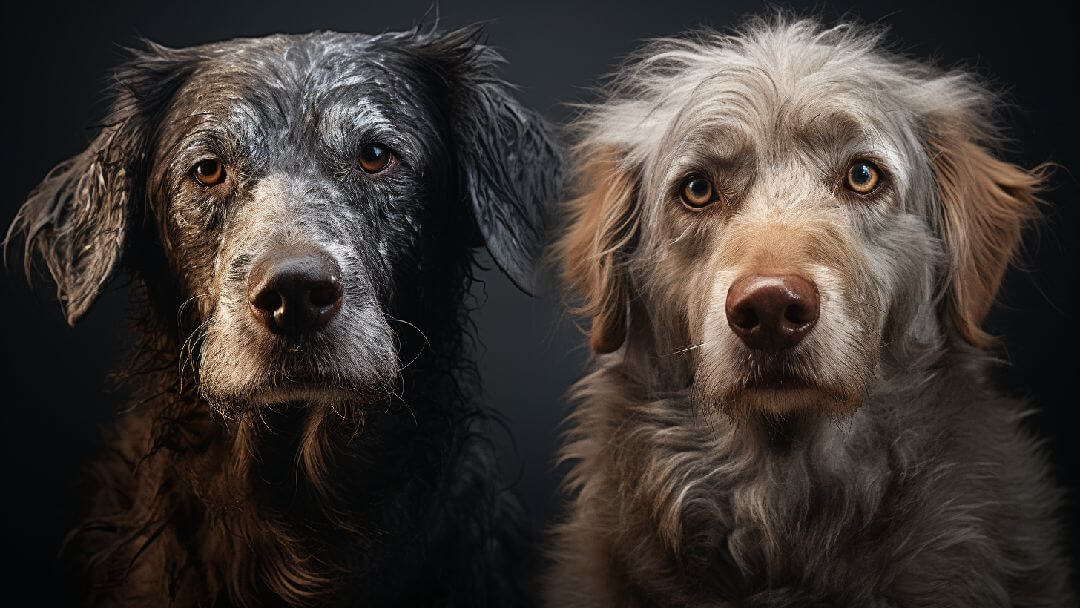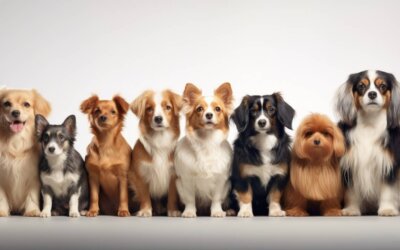Dogs hold a special place in our hearts, evolving from energetic pups to cherished companions. Understanding when dogs transition into their senior years is pivotal for providing tailored care.
Let’s delve into the intricacies of recognizing and embracing the signs of aging in our beloved dogs.
When is a Dog Considered a Senior?
Typically, a dog is considered a senior when they reach the age of 7, although this can vary based on factors like breed and size.
As our furry friends age, various physical and behavioral changes become more pronounced, signaling the onset of their golden years.
10 Dog Aging Signs
Explore the subtle signals of your canine companion’s aging journey. From graying fur to reduced activity, discover the 10 signs that reveal your dog’s advancing years with care.
1. Gray Muzzles and Fur
One of the most visible signs of aging in dogs is the appearance of gray fur, especially around the muzzle. This distinguished silver shading often becomes a badge of honor, showcasing the passage of time.
2. Decreased Energy Levels
As dogs age, their once boundless energy may wane. While a gradual decrease in energy is normal, abrupt or extreme changes could indicate underlying health concerns, necessitating a closer look.
3. Joint Stiffness and Arthritis
Arthritis in older dogs is a common ailment among senior dogs, leading to joint stiffness and discomfort. Observing any hesitancy in movement or reluctance to engage in physical activities can signal the onset of this condition.
4. Changes in Sleep Patterns
Senior dogs often experience alterations in their sleep patterns. Increased daytime napping and disruptions during nighttime rest might become more prevalent. Monitoring these changes helps in understanding your dog’s evolving needs.
5. Dental Issues
Dental problems can escalate with age, causing pain and discomfort. Keep an eye out for changes in eating habits, bad breath, or difficulty while chewing, as these may indicate dental concerns.
6. Canine vision changes
Like humans, dogs may encounter vision and hearing impairments as they age. If you notice your furry friend bumping into objects or becoming less responsive to sounds, it’s time for a veterinary check-up.
7. Weight Fluctuations
Maintaining a healthy weight is crucial for senior dogs. Changes in appetite, unexplained weight loss or gain, and alterations in body condition warrant attention, as they can indicate underlying health issues.
8. Behavioral Changes in Aging Dogs
Alterations in behavior, such as increased irritability, anxiety, or a shift in social interactions, may signal cognitive dysfunction in dogs or other age-related issues. Understanding and addressing these changes is essential for your dog’s well-being.
9. Reduced Immunity
Senior dogs may experience a decline in immune function, making them more susceptible to illnesses. Regular veterinary check-ups and preventive care become paramount to ensuring their overall health.
10. Fur Texture Changes
The texture of a dog’s fur may evolve with age. While some may experience a thinning coat, others might develop a coarser texture. Regular grooming and monitoring help identify and manage these changes.

Unveiling the Social Signs of Mental Aging in Dogs
Just like humans, dogs undergo mental aging, and understanding the social signs becomes crucial in providing them with the care and support they need.
- Changes in Interaction Patterns
One of the dogs’ first social signs of mental aging is a shift in their interaction patterns. Aging dogs may become less enthusiastic about playtime, show diminished interest in social activities, and even tend to seek more solitude.
- Altered Response to Familiar Faces
As dogs age, their ability to recognize familiar faces may decline. Your once-exuberant pup might seem less responsive or take longer to recognize family members and close friends. This can be attributed to cognitive changes and a natural part of the aging process.
- Increased Anxiety or Restlessness
Aging dogs may experience heightened anxiety or restlessness, often triggered by changes in their environment or routine. This social sign can manifest as pacing, excessive whining, or seeking constant reassurance.
- Decreased Interest in Social Hierarchy
In their younger years, dogs often exhibit a clear social hierarchy within their human and canine packs. However, this interest in maintaining or challenging the established hierarchy may diminish as they age.
- Changes in Vocalization
Vocalization is a key aspect of a dog’s communication, and alterations in their barking patterns can signal mental aging. Some aging dogs may become more vocal, expressing their needs or discomfort more frequently. On the other hand, barking might decrease as they become less responsive to external stimuli.
How You Can Help Your Aging Dog
Now that we’ve explored the social signs of mental aging in dogs let’s focus on how you can actively contribute to your dog’s well-being.
- Providing Mental Stimulation
Engage your aging dog in activities that stimulate their mind. Puzzle toys, interactive games, and gentle training sessions can help keep their cognitive functions sharp and provide a sense of accomplishment.
- Maintaining a Consistent Routine
Establishing a predictable routine is vital for an aging dog’s sense of security. Regular feeding times, walks, and play sessions create a stable environment, reducing anxiety and promoting safety.
- Creating a Comfortable Environment
As dogs age, their physical comfort becomes increasingly important. Provide soft bedding easy access to water, and consider ramps or steps to assist with mobility challenges. A comfortable environment contributes to their overall well-being.
- Regular Veterinary Check-ups
Routine veterinary check-ups are crucial to identifying and addressing age-related health issues early on. Regular examinations, vaccinations, and dental care can contribute to a healthier and more comfortable aging process.
- Patience and Understanding
Patience and understanding are perhaps the most important aspect of supporting an aging dog. Be attuned to their changing needs, adapt your interactions accordingly, and cherish the moments you spend together.

7 Senior Dog Care Tips
1. Balanced Nutrition: Tailor your dog’s diet to their changing needs, incorporating nutrients vital for senior dogs.
2. Joint Health Support: Invest in supplements to promote joint health, especially for breeds prone to arthritis.
3. Regular Exercise: Adapt exercise routines to suit your dog’s capabilities, keeping them active without straining their aging bodies.
4. Comfortable Sleeping Space: Provide a cozy and orthopedic bed to ensure a comfortable night’s sleep, which is crucial for senior dogs.
5. Maintain a Healthy Weight: Watch their diet to prevent obesity, a common issue in senior dogs that exacerbates health problems.
6. Gentle Grooming: Regular grooming sessions keep your dog clean and help you detect lumps, bumps, or skin issues early.
7. Dental Care: Dental health is paramount; ensure regular teeth cleaning and provide dental treats to maintain oral hygiene.
Conclusion
As our canine companions gracefully age, providing them with the right care becomes a testament to the love and joy they’ve brought into our lives.
Embrace the aging journey together, creating lasting memories and cherishing the bond that time cannot fade.
Discovering the right balance of nutrition, exercise, and veterinary support becomes essential in providing them with a comfortable and happy golden years.

FAQs
What are the facts about dog age?
One dog year is not equal to seven human years. It varies: the first two years of a medium-sized dog’s life are roughly 12 human years each, and each year thereafter is equivalent to around 4 human years.
How can I tell if my dog is experiencing vision changes due to aging?
Watch for signs like bumping into objects, reluctance to navigate stairs, or changes in eye appearance. Regular vet check-ups can catch issues early.
Are certain dog breeds more prone to arthritis in old age?
Larger breeds and those with genetic predispositions are more susceptible. Regular joint health monitoring and tailored care are crucial.
How do I create a comfortable sleeping space for my senior dog?
Invest in an orthopedic bed to support aging joints. Place it in a quiet, warm area, providing a retreat for restful sleep.
Can I continue exercising with my senior dog?
Gentle exercises like short walks and low-impact play support physical health without causing strain. But adjust activities to their capabilities.






very interesting, thank you!
It’s tough watching our furry friends age. Your insights on signs to watch for were very helpful.
Seeing my dog age has been tough